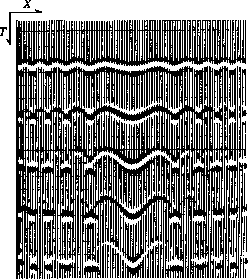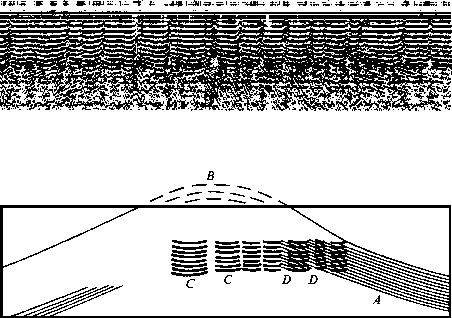![[*]](http://sepwww.stanford.edu/latex2html/cross_ref_motif.gif) to
to ![[*]](http://sepwww.stanford.edu/latex2html/cross_ref_motif.gif) .
.
The exploding-reflector concept does not apply to multiple reflections,
so there is no simple wave-theoretic means of predicting
the focusing behavior of multiples on a near-trace section.
Luckily multiples on vertical plane-wave stacks are analyzable.
They may give us some idea about the focusing behavior of
multiple reflections on other seismic sections.
A vertically downgoing plane wave is simulated
by a common-geophone stack without moveout.
This isn't the same as the familiar CDP stack,
but it is analyzable with the techniques described
in chapters ![[*]](http://sepwww.stanford.edu/latex2html/cross_ref_motif.gif) to
to ![[*]](http://sepwww.stanford.edu/latex2html/cross_ref_motif.gif) .
.
Consider a multiple reflection that has undergone several surface bounces. The seismic energy started out as a downgoing plane wave. It remained unchanged until its first reflection from the sea floor. The sea-floor bounce imposed the sea-floor topography onto the plane wave. In a computer simulation the topography would be impressed upon the plane wave by a step with the lens equation. Then the wave diffracted its way up to the surface and back down to the sea floor. In a computer another topographic lens shift would be applied. The process of alternating diffraction and lensing would be repeated as often as you would care to keep track of things. Figure 10 shows such a simulation. A striking feature of the high-order multiple reflections in Figure 10 is the concentration of energy into localized regions. It is easy to see how bounces from concave portions of the sea floor can overcome the tendency of acoustic energy to spread out. These regions of highly concentrated energy that occur late on the time axis do not resemble primaries at all. With primaries a localized disturbance tends to be spread out into a broad hyperbola. Primary migration of the highly concentrated bursts of energy seen on Figure 10 must lead to semicircles.
|
multfocus
Figure 10 Simulated sea-floor multiple reflections. The vertical exaggeration is 5. Little focusing is evident on the gentle sea-floor topography, but much focusing is evident on high-order multiple reflections. At late times there is a lack of lateral continuity, really unlike primary reflection data. |  |
Such semicircles are most unlikely geological models--and are all too often predicted by the industry's best migration programs.
The most important thing to learn from the synthetic multiple reflections of Figure 10 is that multiples need not resemble primaries. Semicircles that occur on migrated stacks could be residual multiple reflections. Unfortunately, there is no simple theory that says whether or not focused multiples on vertical wave stacks should resemble those on zero-offset sections or CDP stacks. Luckily some data exists that provides an answer. Figure 11 is a zero-offset section which establishes that such focusing phenomena are indeed found in qualitative, if not quantitative, form on reflection survey data.
 |
The marine data exhibited in Figure 11 clearly displays the focusing phenomena in the synthetic calculations of Figure 10. This suggests that we should utilize our understanding in a quantitative way to predict and suppress the multiple reflections in order to get a clearer picture of the earth's subsurface. There are several reasons why this would not be easy to do. First, the Riley theory applies to vertical wave stacks. These are quantitatively different from common-midpoint stacks. Second, the effective seismic sea-floor depth is not a known input: it must somehow be determined from the data itself. Third, the water depth in Figure 11 is so shallow that individual bounces cannot be distinguished.